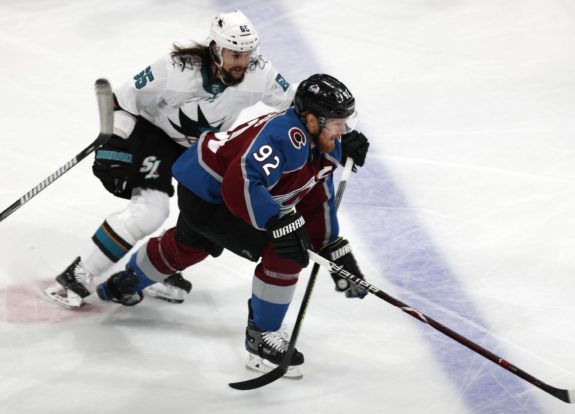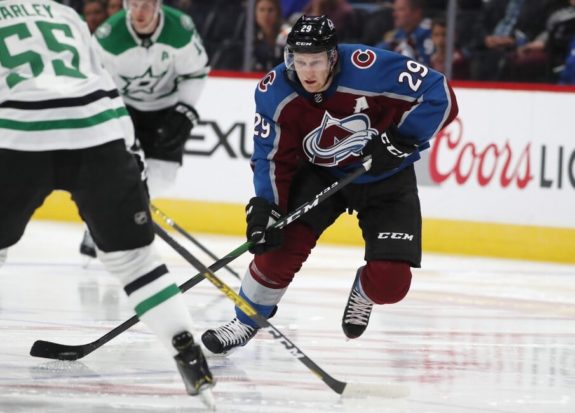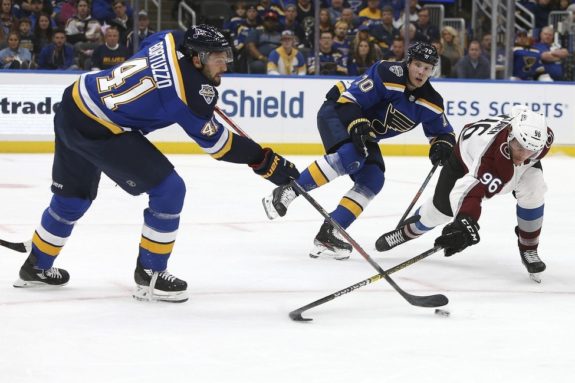The Colorado Avalanche fell victim to several injuries during the 2019-20 season. The injury bug did not play any favorites, injuring superstars and role players alike, both early and late in the season. When the NHL suspended play in mid-March for the coronavirus, the Avalanche’s injury list looked like it was the starting lineup for an All-Star game. With so many injuries to vital players, it’s fair to wonder whether luck played a part in their success.
Despite losing over 200 games to injury, the team is sitting only two points behind the St. Louis Blues for the top seed in the West. If the season had not paused, then Nate MacKinnon, Mikko Rantanen, Nazem Kadri, Andre Burakovsky, and Matt Calvert were expected back in the lineup before the end of the regular season.
Related: Ranking NHL Teams By Forwards
It was disheartening when the season paused because the team was so close to having a full squad together in what seemed like ages. It felt like the momentum of the season would dissipate (the argument of whether momentum is real is for another day). With so much time away from coaches, teammates, and training staff, can we expect the team to perform well once league play resumes?
How is Luck Measured?
We can use the metric SHSV% as our measurement of luck. It is the sum of even-strength (ES) shooting percentage (SH) and ES save-percentage (SV). It may seem unconventional to apply save-percentage to skaters, but hockey is a fluid game with players cycling through every zone during their shifts. Sometimes it is important to use metrics that capture that movement.

The average NHL team has an SHSV% value of 1.000, and values significantly above that mean that luck was heavily involved in the team’s performance. I am using SHSV% to determine whether the Avalanche were lucky this season or whether this season was an accurate reflection of their effectiveness.
Related: Worst Teams in Stanley Cup Playoff History
Colorado’s SHSV% was 1.018, third highest in the NHL this season, behind the Boston Bruins and Tampa Bay Lightning (both tied at 1.022). From 2015-19, the playoff team with the highest regular-season SHSV% were the 2016-17 Washington Capitals (1.027), and the lowest rate by a playoff team was by the 2018-19 Carolina Hurricanes (0.992). This makes sense on its face – teams win when they outscore and out-save their opponents – but the real picture starts to form when examining the SHSV% of each forward line.
Were the Avalanche Good, Lucky, or Both?
The Avalanche sent out 21 forward line combinations this season that were on the ice for at least two goals. All 21 lines combined were on the ice for 96 goals (for brevity’s sake, I’m linking the Line Production table from Left Wing Lock here). Six of the 21 lines had SHSV% below 1.000 and five lines were in the range of the 2015-19 playoff teams (1.000-1.027). Table 1 below shows this information.
Table 1. SHSV% values for Avalanche lines on the ice for at least two goals
| SHSV% Values | No. of Lines | No. of Lines (%) | No. of Goals | No. of Goals (%) |
| Below 1.000 | 6 | 29% | 33 | 34% |
| 1.001 – 1.027 | 5 | 24% | 24 | 25% |
| Above 1.027 | 10 | 47% | 39 | 41% |
| Totals | 21 | 100% | 96 | 100% |
We know that there were line combinations that only came together to compensate for injury absences. These lines partnered top scorers with fourth-liners and those with AHL call-ups. I believe that there’s a high likelihood that those lines are Matt Nieto/MacKinnon/Joonas Donskoi, Pierre-Edouard Bellemare/Valeri Nichushkin/Logan O’Connor, and J.T. Compher/Tyson Jost/Colin Wilson. Table 2 below contains the new weightings if those lines’ productions are removed.

Table 2. SHSV% values for Avalanche lines on the ice for at least two goals, excluding outlier lines
| SHSV% Values | No. of Lines | No. of Lines (%) | No. of Goals | No. of Goals (%) |
| Below 1.000 | 6 | 33% | 33 | 38% |
| 1.001 – 1.027 | 5 | 28% | 24 | 28% |
| Above 1.027 | 7 | 39% | 30 | 34% |
| Totals | 18 | 100% | 87 | 100% |
The scoring from over 60% of the lines above was most likely not the result of luck, and they accounted for two-thirds of the goals. In Table 3 below, the Avalanche’s top line of Landeskog-MacKinnon-Rantanen produced under the league average (0.970), which is unlikely to continue now that they are all healthy.
Table 3. Avalanche forward lines below 1.000 SHSV% during 2019-20 season (GF = Goals For)
| F1 | F2 | F3 | GF | % of Total | SHSV% |
| DONSKOI | MACKINNON | KADRI | 3 | 3.45% | 944 |
| BURAKOVSKY | MACKINNON | RANTANEN | 2 | 2.30% | 963 |
| NIETO | NICHUSHKIN | BELLEMARE | 4 | 4.60% | 966 |
| LANDESKOG | MACKINNON | RANTANEN | 20 | 22.99% | 970 |
| COMPHER | JOST | KADRI | 2 | 2.30% | 993 |
| LANDESKOG | MACKINNON | DONSKOI | 2 | 2.30% | 997 |
What’s interesting about Table 3 is that the majority of the lines are a mix of top-six forwards, and the data shows that they have been unlucky this season. It’s not as if these were the checking- and fourth-liners who aren’t scoring. This reality should absolutely terrify the rest of the Western Conference.
Table 4. Avalanche forward lines between 1.001-1.027 SHSV% during 2019-20 season
| F1 | F2 | F3 | GF | % of Total | SHSV% |
| NIETO | JOST | KAMENEV | 2 | 2.30% | 1003 |
| BURAKOVSKY | MACKINNON | DONSKOI | 4 | 4.60% | 1013 |
| NIETO | CALVERT | BELLEMARE | 6 | 6.90% | 1015 |
| BURAKOVSKY | KADRI | DONSKOI | 6 | 6.90% | 1019 |
| BELLEMARE | NICHUSHKIN | CALVERT | 6 | 6.90% | 1022 |
Table 4 mostly consists of middle-six forwards who the team expects to contribute at the frequency above. There are no outliers here any more than there are in Table 3. I would expect to see more Vlad Namestnikov instead of Nieto here, which would benefit the Avalanche.

Though not shown, it’s reasonable to expect that some of the lines producing above 1.027 would revert to the mean (aka the league average of 1.000). There’s nothing glaringly obvious about the data presented here that leads me to think that the Avalanche cannot continue to score. In fact, they may even perform better than they have, given the return of sharpshooters like MacKinnon, Rantanen, Kadri, and Burakovsky.
If the NHL returns to finish the rest of the regular season, then the Avalanche’s strength of schedule is somewhat favorable. Through March 12, they had played the 11th softest schedule, and have the 18th softest remaining. The team that they are chasing for the top-seed – the St. Louis Blues – has the 21st softest. The Avalanche also have more home games left than do the Blues, and they’ve played one less game, so there is ample opportunity to overtake them for the top seed in the West.
Through the variety of injuries, line combinations, and uncertainty, the Avalanche have demonstrated that they are an exceptionally deep team that can win the Western Conference. The data shows that their production is not the result of luck, and so they should continue to play lights-out hockey upon their return to the ice. For Colorado fans, let’s hope that NHL Commissioner Gary Bettman allows that to happen.